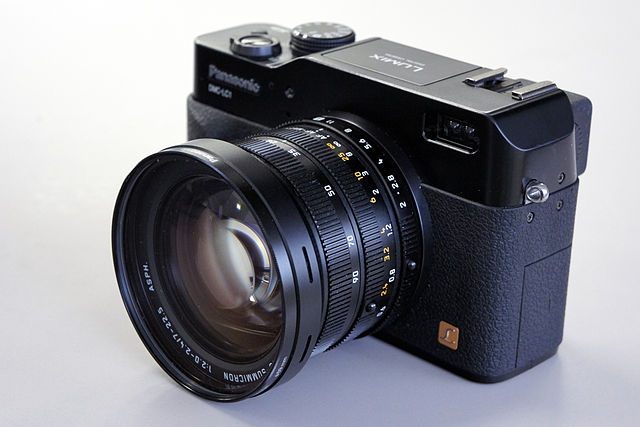Top Qs
Timeline
Chat
Perspective
List of digital cameras with CCD sensors
From Wikipedia, the free encyclopedia
Remove ads
There has been renewed interest in vintage digital cameras, also known as digicams, due to their ability to take photos with a particular nostalgic look without the expense of analog film.[1][2][3][4] This trend coincides with the resurgence of other early digital and late analog technologies, such as camcorders, film photography, vinyl records, and turntables.[5]

This is a list of digicams that contain a 1/1.7″ CCD sensor or larger, include a fixed lens, and support SDHC memory cards and one or more of the following: SDXC memory cards,[6] raw image format capture,[7] and AA or AAA batteries.[a] These are features that help make an old camera easy to use today.
Notably, no Fujifilm Super CCD digicams qualify, because none support SDXC, raw capture, or AA/AAA batteries. Arguably their best models ever released, such as the FinePix F31fd, only support xD memory cards, which are now obsolete.
Remove ads
Rationale for criteria
Summarize
Perspective
Fixed lens
Although the term “digicam” originated as a syllabic abbreviation for “digital camera”, it is now used primarily to refer to an old compact digital camera or, in other words, a discontinued point-and-shoot camera with a fixed lens.[32][33][34] Digicams emphasize portability and ease of use, and they often include a built-in flash.[35]
1/1.7″ CCD sensor or larger
CMOS sensors have entirely replaced CCD sensors in recent consumer digital cameras due to cost effectiveness and high ISO performance. However, in good lighting conditions, many people find that the CCD sensors in digicams yield a more pleasing color rendition than CMOS sensors.[33] Some liken CCD to slide film (also known as positive film) and CMOS to negative film.[36]
While there were larger CCD sensors made for interchangeable-lens cameras, such as the Leica M9, CCD sensors in fixed-lens cameras maxed out at 2/3″ (1/1.5″). Premium compact cameras of the time contained sensors around 1/1.7″ in size, whereas entry-level models used 1/2.3″ sensors or smaller.[37][38][39]
SDHC and SDXC cards
Early digital cameras used a variety of formats for storage. Eventually SD cards won the format war, and they are still widely used and readily available. However, the original SD format maxes out at 2GB and is now rare. Cards today far exceed that by using one of two format extensions: SDHC, which maxes out at 32 GB, or SDXC, which maxes out at 2 TB. SDXC support is more future-proof, but SDHC cards are still common and inexpensive. Support for the newer formats is important, because memory card slots are not usually forward compatible.[citation needed][original research?]
Raw image format
While the appeal of digicams stems from the ability of obtain pleasing results with a nostalgic look straight out of camera, capturing in a raw format maximizes the ability to edit an image to one's taste or recover details (such as highlights and shadows) that might otherwise be lost in the JPEG version, especially given the low dynamic range of these small-sensor cameras.[40]
AA or AAA batteries
New consumer digital cameras with CCD sensors stopped being released in the early 2010s, and the few that offered USB charging only supported it via a non-standard cable.[41] Proprietary cables, chargers, and batteries can be difficult to come by, especially when discontinued, which makes support for standard AA or AAA batteries (especially rechargeable NiMH cells) a desirable feature.[42]
Remove ads
Larger CCD sensors
Summarize
Perspective

The following digicams include a 2⁄3-inch CCD sensor, a fixed lens with a maximum aperture of f/2.4 or wider, and SD or CompactFlash (CF) memory card slots. However, none of them support SDHC/SDXC memory cards. Only the Olympus E-10/E-20 support AA batteries, none of the others accept AA/AAA batteries.
Even larger CCD sensors were only included in interchangeable-lens cameras, such as the Canon 1D, Nikon D60, and Leica M9. Nearly all such models were more expensive and less beginner-friendly than the point-and-shoot cameras listed here.
Remove ads
Smaller CCD sensors

There are hundreds of digicam models — the most popular of which are from the Canon PowerShot ELPH, IXUS, and IXY series — that contain a smaller CCD sensor and support SDXC memory cards.[51] Unfortunately none of them support USB charging.[52] However several dozen, such as the Nikon Coolpix A10, do support AA batteries.[53]
See also
Notes
- Rebadged by Leica as the D-Lux 5.
- Rebadged by Leica as the D-Lux 4.
- Rebadged by Leica as the D-Lux 3.
- Rebadged by Leica as the D-Lux 2.
- Known as the Samsung EX1 in Europe.
References
Wikiwand - on
Seamless Wikipedia browsing. On steroids.
Remove ads
